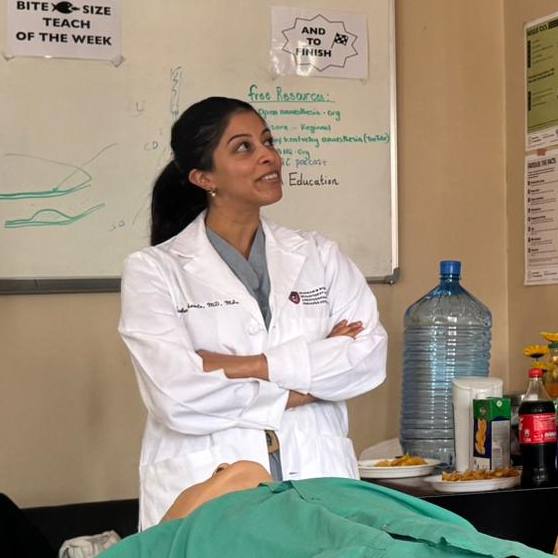-
Replication: mentor trains student on tick-borne viruses
Crystal Mendoza and Hideki Ebihara, Ph.D., are a student-mentor match made in a viral hot zone. They were drawn together by a shared passion for emerging tick-borne viruses, a growing problem in the U.S. and around the world.
Mendoza, a Ph.D. candidate in virology and gene therapy at Mayo Clinic Graduate School of Biomedical Sciences, wants to develop ways to diagnose, prevent and treat two emerging tick-borne virus infections. Dr. Ebihara, a Mayo Clinic virologist, heads a laboratory striving to improve the ability to counteract emerging diseases transmitted by ticks and insects.

Crystal Mendoza and Hideki Ebihara, Ph.D.
The Match Game
Mendoza has been preparing for a career in biomedical research since high school.
"I grew up watching bad science movies, and that inspired me to change the way the public understands what scientists actually do," says Mendoza. She developed an interest in virology while studying cellular and molecular biochemistry at The University of Texas at El Paso. "I wanted to understand how viruses make people sick and ways to treat people once they're infected."
After graduating, Mendoza enrolled at Mayo Clinic Graduate School of Biomedical Sciences. She planned to become a molecular virologist and study the biological mechanisms that enable a virus to produce disease (pathogenesis), as well as how to interfere with the viral life cycle and virus-induced immune responses. She found the perfect mentor in Dr. Ebihara. He came to Mayo Clinic in 2016, and his research program focuses on infectious viruses that jump from animals to humans, called "zoonotic diseases." Dr. Ebihara had previously worked on these viruses at the National Institute of Allergy and Infectious Diseases in the Laboratory of Virology.
"Apart from being a fantastic and supportive mentor, he has expertise in pathogenesis," Mendoza says. "He has experience running a lab with the highest biosafety level. Getting training from him was the perfect fit for what I wanted to study."
The Story Behind Tick-Borne Viruses
Total reported cases of tick-borne illnesses tracked by the Centers for Disease Control and Prevention rose between 2004 and 2013 from 22,527 to 46,231. By 2017, the number of cases had increased further to 59,349, including cases of Lyme disease, anaplasmosis, spotted fever rickettsiosis, babesiosis, tularemia, and Powassan virus. And even that number may be low based on extrapolation from Lyme disease lab testing.

These illnesses can be caused by a bacteria or virus. For example, Lyme disease is caused by bacteria, but in other cases, such as babesiosis, viruses are the cause. In general, though, Dr. Ebihara says that the rise in these illnesses reflects growing human contact with wilderness, whether for agriculture, adventure or residential development.
"Infectious tick-borne disease has increased in the last three or four decades because of expanding human society," Dr. Ebihara says. "We see an increasing number of new viruses, and we will have more in the future. Research is needed because we cannot win by trying to eliminate ticks from our world."
In addition to ticks, most zoonotic diseases are transmitted by mosquitoes, rodents and bats. The ones that are emerging, Dr. Ebihara says, are newly evolved, newly encountered by humans, or newly determined to cause disease. A changing climate, too, may contribute to the increase.
"Climate change is encroaching on wildlife, causing animals to migrate, and carry ticks and viruses with them," Mendoza says. "Warmer summers and milder winters mean the active season for ticks is getting longer."
Student-Centered Mentoring
At many graduate schools, students are assigned to a faculty member with available research dollars. The students' interests and theses may or may not align with their mentors' areas of expertise. Mayo takes a different approach, called "student-centered mentoring," which makes it a priority to pair the graduate student with the right mentor. To ensure that funding doesn't limit choice, the graduate school allocates research dollars to each student, and those research dollars accompany the student to the mentor's lab. Students are "free agents," able to decide which faculty members can best prepare them for their chosen specialty. Mendoza says the freedom to choose Dr. Ebihara as her mentor was crucial to her training.

"In general, I've become much better about how I use science," she says. "I'm more creative in designing experiments. I'm so thankful to him."
In turn, he feels honored to be Mendoza's mentor and believes it's important to train more virologists because there's no end to emerging viruses.
"She has a passion for science, especially for the research of infectious diseases and virology," he says. "She is very interested in what she is doing, which is a good driving force."
Answers From Understanding
Blood-feeding insects like ticks spread a virus by biting an infected mammal and then biting other mammals, including deer, raccoons, rabbits and humans. The virus does not cause disease in the tick, but it can cause serious illness in humans. Mendoza is focused on two that cause human hemorrhagic feverlike diseases. Only certain tick-borne viruses (all in the Bunyavirus family of viruses) cause these illnesses in humans.
"These viruses are finely tuned to surviving and are equipped to evade host defense systems," Dr. Ebihara says. In a human, the virus enters at the bite site. Viral proteins interact with cellular proteins to invade and hijack control of a host cell. The virus uses the cell's machinery to make copies of itself, which then infect neighboring cells and inhibit antiviral functions. The virus spreads throughout the body via the lymphatic and circulatory systems.
"Zoonotic viruses just want to multiply," Dr. Ebihara says. "Disease is just a result of infection. Sometimes, the virus is too good at controlling immune response."
Basically, these viral particles prevent the body from controlling the vascular system and trigger a faulty immune response. This combination creates complicated disease processes. Dysregulation causes reduction of white blood cells, the army of the immune system. It also causes problems with platelets, blood cells that help blood clot, compounding bleeding from vascular damage. Also, some viruses become infectious to other humans through blood and other bodily fluids.
"That's why a patient with this kind of viral infection is so difficult to treat," Dr. Ebihara says. "The immune system cannot react in the correct way." In fact, most symptoms are caused by the immune system's response to infection and its own impairment.
Dr. Ebihara says the key to research advances is to learn how the virus works: "To understand the disease caused by emerging viruses, we need to know the molecular mechanisms. Then we can apply that understanding to design countermeasures. The final goal is always prevention, control and treatment."

By studying the biological and molecular mechanisms that enable a virus to produce disease, Dr. Ebihara's team hopes to find ways to change or halt the viral life cycle.
The transition of a virus from harmless to disease-causing involves a series of encounters between viral proteins and proteins in the host cell. By studying the biological and molecular mechanisms that enable a virus to produce disease, Dr. Ebihara's team hopes to find ways to change or halt the viral life cycle.
"If we understand what happens in the virus-host interaction, we can design a drug to interfere with the mechanism," Dr. Ebihara says. And, he adds, if they can find a common pathway shared by many viruses, that could lead to developing a universal drug to prevent or treat disease.
Understanding also may lead to new diagnostics for illnesses that often present as a mystery.
Applied Learning
Mendoza's thesis focuses on two emerging pathogens: Heartland virus, reported in more than 30 people in Midwest and southern states as of 2017, and severe fever with thrombocytopenia syndrome virus, reported in thousands of people in China, South Korea and Japan.
To study the viruses safely, Mendoza replaces the viral gene with one that is detectable, called a "reporter gene." That allows her to measure viral replication and transcription processes but does not produce infectious virus.
"We can look at one part of the viral life cycle and quantify it over time," she says. "And we can use it as a tool to screen potential therapeutics."
Or even vaccines.
Once the team identifies a specific genetic sequence in the virus that expresses disease in humans, reverse-genetics technology can be used to produce a live, attenuated vaccine from cloned DNA.
To date, testing in mammalian cell lines identified two inflammation inhibitors that reduced replication up to 90 percent. "I'm really excited," Mendoza says. "The part I'm most interested in is why these compounds work. What in the cell does the virus need for replication and transcription, and how is it being inhibited by the compounds we identified?"
Through collaboration with a former colleague, Dr. Ebihara arranged to have the compounds tested on infectious viruses at Hokkaido University.
"Her project is very significant," Dr. Ebihara says. "We do not have a magic bullet to cure diseases caused by tick-borne viruses. Her research directly connects to finding a cure for specific diseases by targeting the disease mechanism."
Until then, Mendoza and Dr. Ebihara say that a vaccine to prevent disease and education of the public to avoid tick exposure are the best approaches to tick-borne hemorrhagic fevers.
Mendoza plans to complete her doctorate in 2019. She remains fascinated with tick-borne viruses and can picture herself continuing in research, developing a public health response, educating the public or communicating the latest advances.
- Jon Holten, May 2019







